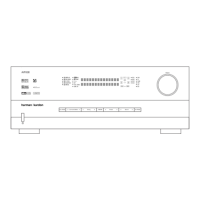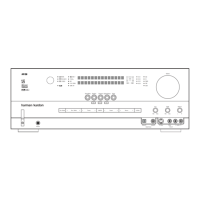SYSTEM CONFIGURATION
22 SYSTEM CONFIGURATION22 SYSTEM CONFIGURATION
display since only one set of component video cables
is needed to view all input sources connected to the
AVR 635. Conversely, the conversion circuitry may be
used to convert component inputs to an S-video or
composite video output when a receiver that is capa
-
ble of displaying a component signal is not available.
In most cases you will want to have the conversion
circuitr
y engaged, but in some installations it may be
preferable to turn it off. If you prefer the way a video
signal looks in its original form, you may turn the video
conversion circuitry off by first making certain that the
IN/OUT SETUP menu (Figure 2) is on the
screen, and then pressing the
⁄
/
¤
Navigation
Button
o until the Ô cursor is pointing to
VIDEO CONV and then press the
‹
/
›
Navigation Button o so that OFF is shown in
highlighted video. This setting is made individually for
each input, so be certain to make any desired change
for each input source where you wish to turn the con-
version circuitry off.
Should you wish to return the conversion circuitry to
the On position at any time, simply use the steps
shown above, but press the
‹
/
›
Navigation Button
o so that ON is shown in highlighted video.
The final input setting is also individual to each input,
and it allows you to set the priority for the video con-
version circuitry. In most cases, where only one type of
video connection is made between a source device
and the AVR you will not need to change this setting,
and if all other parameters have been adjusted to
meet your system requirements, you may proceed to
the next configuration steps by pressing the
⁄
/
¤
Navigation Button o until the Ô cursor is point-
ing to
BACK
TO MASTER MENU
and then
pressing the
Set Button p.
In some cases when you wish to set a specific input
for the video conversion circuits, a change to the set-
ting here is required.
In the
Automatic mode
, the AVR
will scan all video inputs and route the first signal it
encounters to the component output. However, in
advanced systems, or when more than one video input
is connected to the same source
,
you may want to
bypass the automatic selection and manually choose
which signal is converted.
For example, in some cases both component and
standard composite video outputs from a set-top box
may be connected to the AVR so that the component
signal is fed to a digital video display and the compos-
ite signal to a recorder. In this case you would not
want the composite signal converted, but rather have
the component signal passed through to the main out-
put with the composite
.
To make this type of system configuration first make
certain that the
IN/OUT SETUP menu
(Figure 2) is on the screen, Next, press the
⁄
/
¤
Na
vigation Button
o until the Ô cursor is point
-
ing to
V-CONV
PORT
.
When the default of
AUTO is shown the unit will first look at the CVBS
(composite video) input, then to the S-video and
Component inputs for the source to be routed to the
component outputs
. To select a specific output, press
the
‹
/
›
Navigation Button o until your desired
choice appears in highlighted video.
When all needed adjustments have been made, press
the
¤
Navigation Button o until the Ô cursor is
next to
BACK
TO MASTER MENU
to con
-
tinue with the system configuration.
Audio Setup
This menu allows you to configure the tone controls
and to turn the upsampling on or off. If you do not
wish to change any of those settings at this time, pro-
ceed to the next menu screen. However, to make
configuration changes to those parameters, make
certain that the
MASTER MENU is on screen
with the Ô cursor pointing to the AUDIO SETUP
line, and press the Set Button q. The AUDIO
SETUP
menu (Figure 3) will appear.
Figure 3
The first line controls whether or not the bass/treble
tone controls are in the signal path.
The nor
mal default
is for them to be in-line, but if you wish to remove
them from the circuit for “flat” response, first make
certain that the
Ô cursor is pointing to the TONE
line on the menu and press the ‹/› Na
viga
tion
Button
o so that OUT is highlighted in reverse
video.
If you wish to leave the tone controls in the signal
path, the amount off boost or cut for bass and treble
may be adjusted by pressing the
⁄/¤ Navigation
Button
o so that the Ô cursor is next to bassor
treble depending on which setting you wish to adjust.
Next,
press the
‹/› Na
viga
tion Button
o until
the desired setting is shown.
This menu also includes a setting to turn the unit’s
upsampling feature on or off. In normal use, this
feature is turned off, which means that digital sources
are processed at their native sample rate. For
example, a 48kHz digital source will be processed
at 48kHz. However, the AVR 635 allows you to
upsample the incoming 48kHz signals to 96kHz
for added resolution.
To take advantage of this feature, press the
⁄/¤
Na
vigation Button
o so that the Ô cursor is next
to the
UPSAMPLING line and press the ‹/›
Navigation Button o so that ON is highlighted in
reverse video. Note that this feature is only available
for the Dolby Pro Logic II-Music, Dolby Pro Logic II-
Movie
, Dolby Pro Logic and Dolby 3 Stereo modes.
When all desired changes have been made on this
menu, press the
⁄/¤ Navigation Button o
so that the Ô cursor is next to the BACK TO
MAIN MENU
line; press the Set Button q.
Surround Setup
T
he next step is to set the surround mode you wish
to use with the input that was previously selected in
the
IN/OUT SETUP menu. Since surround
modes are a matter of personal taste, feel free to
select any mode you wish – you may change it later.
However, to make it easier to establish the initial
parameters for the AVR 635, we suggest Logic 7
(Cinema or Music) for most analog inputs. In the case
of inputs such as a CD Player, Tape Deck or Tuner, you
may wish to set the mode to Stereo (“Surround off”)
as they are not typically used with multichannel pro-
gram material, and it is unlikely that sur
round-encoded
material will be used. Alternatively, the
Logic 7 Music
mode is a good choice for stereo-only source material.
See page 34 for more information on available sur-
round modes.
For digital program material, the AVR will always exam-
ine the data stream and automatically select a Dolby
Digital or DTS mode as applicable.
It is easiest to complete the surround setup using the
full-OSD on-screen menus. From the
MASTER
MENU (Figure 1),
press the
⁄
/
¤
Na
vigation
Button
o until the Ô cursor is next to the
SURROUND SELECT line. Press the Set
Button
q until the SURROUND SELECT
menu (Figure 4) is on the screen.
Figure 4
** SURROUND SELECT **
DOLBY SURROUND
DTS
LOGIC 7
DSP (SURR)
STEREO
BACK TO MASTER MENU
ÔÔ
* AUDIO SETUP *
TONE :IN OUT
BASS :0
TREBLE :0
ADC SAMPLING:48k 96k
BACK TO MASTER MENU
→→
AVR 635 OM 12/2/04 3:28 PM Page 22

